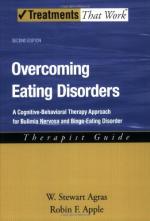|
This section contains 503 words (approx. 2 pages at 300 words per page) |

|
An eating disorder marked by episodes of binge eating followed by one or more behaviors to control weight, most commonly self-induced vomiting, laxative abuse, fasting, or excessive exercise.
Bulimia tends to appear in late adolescence or early adulthood, and most cases occur among middle- and upper-class females. The binge-purge episodes are almost always kept secret, and they tend to follow a recurrent pattern with at least two episodes per week. Like anorexia nervosa, bulimia has its roots in complex social and emotional issues. The family histories of bulimic youth often include emotional chaos, excessive anger, depression, substance abuse, and physical or sexual abuse.
Physical Effects
Although bulimia is not associated with the severe weight loss of anorexia nervosa, it does cause a number of serious health risks, the most significant of which are gastrointestinal. Consequences of frequent vomiting include damage to the esophagus, stomach, pancreas, and...
|
This section contains 503 words (approx. 2 pages at 300 words per page) |

|


